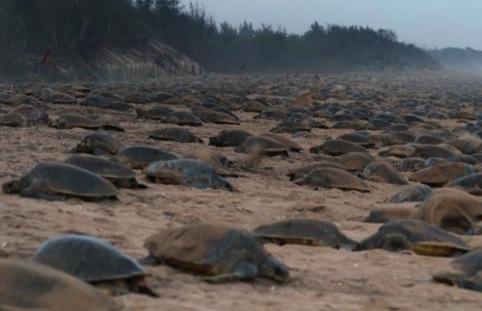
Olive Ridleys Thrive, But Green Turtles Pose Seagrass Concerns
The Indian Ocean is home to a diverse array of marine life, with many species calling its waters their home. Among these, the olive ridley sea turtle and the green turtle are two of the most iconic and widespread species. While olive ridleys are thriving in some parts of the country, green turtles are facing unique challenges that have significant implications for local ecosystems and fisheries.
According to a recent report by Research Matters, mass nesting of olive ridleys has been observed in several parts of India, including the Lakshadweep islands. This is a welcome development, as olive ridleys are an endangered species and their numbers have been declining in recent years. The report attributes the increase in olive ridley nesting to conservation efforts and the implementation of sustainable fishing practices.
However, the report also highlights a new threat to the marine ecosystem of Lakshadweep: the grazing impacts of green turtles on seagrass meadows. Seagrass meadows are critical habitats for many marine species, providing shelter, food, and breeding grounds for fish, crustaceans, and other invertebrates. However, the grazing activities of green turtles are threatening the health and resilience of these ecosystems.
Seagrass meadows are found in shallow coastal waters and are characterized by dense beds of seagrass, which are an important food source for many marine animals. The meadows also provide a nursery ground for many fish species, as well as a habitat for juvenile fish to grow and develop. However, the grazing activities of green turtles can damage the seagrass and reduce its ability to provide these critical ecosystem services.
The report suggests that the increasing numbers of green turtles in Lakshadweep are a result of the warming of the Indian Ocean, which is causing a shift in the distribution and abundance of marine species. While this may be good news for green turtle populations, it poses significant challenges for the local ecosystem and fisheries.
The grazing impacts of green turtles on seagrass meadows can have far-reaching consequences for the local fish population. Many fish species rely on seagrass meadows as a food source, and the degradation of these habitats can lead to declines in fish populations. This can have significant implications for local fisheries, which are an important source of income and food for many communities.
Addressing the interactions between green turtles and seagrass meadows is critical for ensuring that both marine ecosystems and local fisheries can coexist harmoniously. This requires a combination of research, conservation, and sustainable management practices.
One approach is to conduct research on the impacts of green turtle grazing on seagrass meadows. This can involve monitoring the health and resilience of seagrass meadows, as well as studying the feeding habits and behavior of green turtles. This information can then be used to develop effective conservation and management strategies.
Another approach is to engage local communities in conservation efforts. Many local communities rely on marine resources for their livelihoods, and they can play a critical role in protecting seagrass meadows and the fish populations that rely on them. This can involve education and outreach programs, as well as the establishment of marine protected areas.
Finally, sustainable management practices can also play a critical role in addressing the interactions between green turtles and seagrass meadows. This can involve the implementation of sustainable fishing practices, such as catch limits and fishing gear restrictions, as well as the establishment of marine protected areas.
In conclusion, while olive ridleys are thriving in some parts of India, green turtles are facing unique challenges that have significant implications for local ecosystems and fisheries. The grazing impacts of green turtles on seagrass meadows are a pressing concern, and addressing these interactions through research and sustainable management is vital for ensuring that both marine ecosystems and local fisheries can coexist harmoniously.
For more information on this topic, please visit the Research Matters website at https://researchmatters.in/news/mass-nesting-olive-ridleys-thrives-new-threats-emerge.
News Source: https://researchmatters.in/news/mass-nesting-olive-ridleys-thrives-new-threats-emerge






